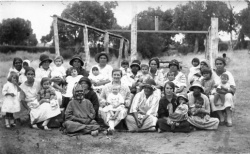IND/Assimilation and 'Biological Absorption
The typical definition of assimilation policies can be seen in this statement from the Australian Aboriginal Affairs Ministers in 1963:
| “ | The policy of assimilation means that all Aborigines and part-Aborigines will attain the same manner of living as other Australians and live as members of a single Australian community enjoying the same rights and privileges, accepting the same responsibilities, observing the same customs and influenced by the same beliefs, hopes and loyalties as others Australians (as cited in Chesterman & Douglas, 2004, p. 48). | ” |
As John Chesterman and Heather Douglas argue, ‘the broad attraction of the policy of assimilation was the promise that it held for the 'ultimate absorption' (in a cultural, if not in a racial sense) of Aboriginality by white Australia, a promise that would end the myriad headaches being caused by the attempts to separate white and black. But just as biological absorptionists hadn't counted on the survival of the Aboriginal race, nor did the ascendant social integrationists count on the survival of Indigenous culture.’ (Chesterman & Douglas, 2004, pp. 48-49).
In order to ensure that Indigenous people were adhering to this ‘same manner of living’, assimilation policy focused on surveillance of Indigenous people, with District Welfare Officers appointed to observe and report on Indigenous life. They awarded so-called ‘Exemption Certificates’ to Aboriginal people who were seen as ‘deserving’, which supposedly allowed access to other services which non-Indigenous people took for granted, such as education, housing or health. In order to get an exemption certificate, people had to agree to live separately from other Indigenous people, giving up ties to family and community.
